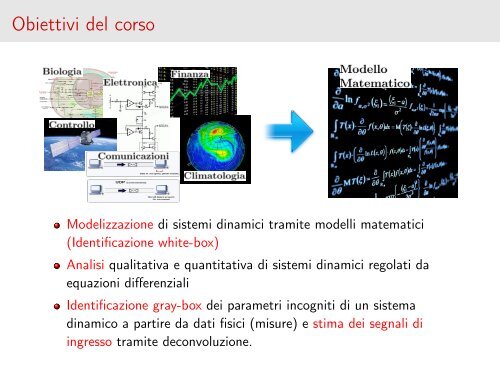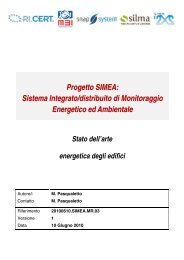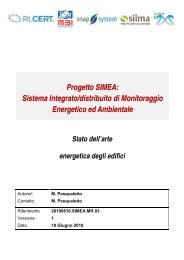Slides - Automatica - Università degli Studi di Padova
Slides - Automatica - Università degli Studi di Padova
Slides - Automatica - Università degli Studi di Padova
You also want an ePaper? Increase the reach of your titles
YUMPU automatically turns print PDFs into web optimized ePapers that Google loves.
Obiettivi del corso<br />
16 CHAPTER 1. INTRODUCTION<br />
Figure 1.12: The wiring <strong>di</strong>agram of the growth-signaling circuitry of the mammalian<br />
cell [HW00]. The major pathways that are thought to play a role in cancer are in<strong>di</strong>cated<br />
in the <strong>di</strong>agram. Lines represent interactions between genes and proteins in the cell. Lines<br />
en<strong>di</strong>ng in arrowheads in<strong>di</strong>cate activation of the given gene or pathway; lines en<strong>di</strong>ng in a<br />
T-shaped head in<strong>di</strong>cate repression. (Used with permission of Elsevier Ltd. and the authors.)<br />
nity is the science of reverse (and eventually forward) engineering of biological<br />
control networks such as the one shown in Figure 1.12. There are a wide variety<br />
of biological phenomena that provide a rich source of examples of control, inclu<strong>di</strong>ng<br />
gene regulation and signal transduction; hormonal, immunological and car<strong>di</strong>ovascular<br />
feedback mechanisms; muscular control and locomotion; active sensing,<br />
vision and proprioception; attention and consciousness; and population dynamics<br />
and epidemics. Each of these (and many more) provide opportunities to figure out<br />
what works, how it works, and what we can do to affect it.<br />
One interesting feature of biological systems is the frequent use of positive feedback<br />
to shape the dynamics of the system. Positive feedback can be used to create<br />
switchlike behavior through autoregulation of a gene, and to create oscillations such<br />
as those present in the cell cycle, central pattern generators or circa<strong>di</strong>an rhythm.<br />
Ecosystems. In contrast to in<strong>di</strong>vidual cells and organisms, emergent properties<br />
of aggregations and ecosystems inherently reflect selection mechanisms that act on<br />
multiple levels, and primarily on scales well below that of the system as a whole.<br />
Because ecosystems are complex, multiscale dynamical systems, they provide a<br />
broad range of new challenges for the modeling and analysis of feedback systems.<br />
Recent experience in applying tools from control and dynamical systems to bacterial<br />
networks suggests that much of the complexity of these networks is due to the<br />
presence of multiple layers of feedback loops that provide robust functionality<br />
Modelizzazione <strong>di</strong> sistemi <strong>di</strong>namici tramite modelli matematici<br />
(Identificazione white-box)<br />
Analisi qualitativa e quantitativa <strong>di</strong> sistemi <strong>di</strong>namici regolati da<br />
equazioni <strong>di</strong>fferenziali<br />
Identificazione gray-box dei parametri incogniti <strong>di</strong> un sistema<br />
<strong>di</strong>namico a partire da dati fisici (misure) e stima dei segnali <strong>di</strong><br />
ingresso tramite deconvoluzione.

















